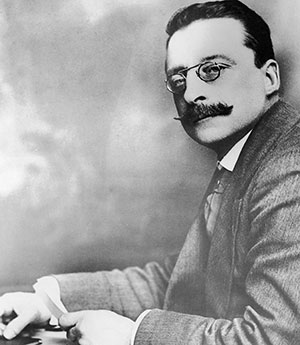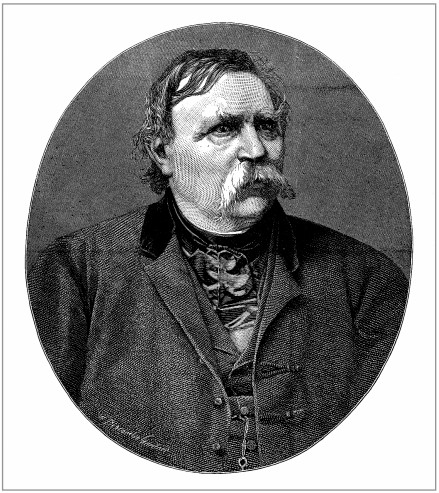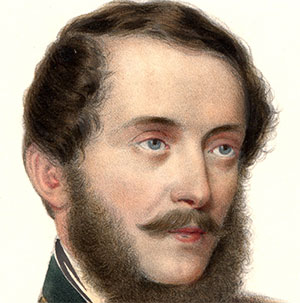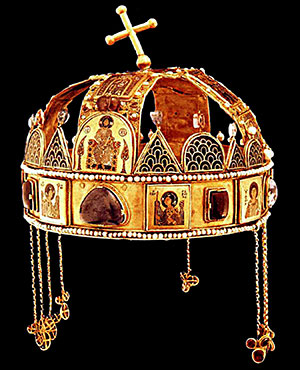Griffith in Nighttown
Published in Features, Issue 3 (May/June 2020), Volume 28A Joycean critique of The resurrection of Hungary?
By Martin Greene

Above: Arthur Griffith—his aim in The resurrection of Hungary was to convince Irish nationalists to follow the lead of their Hungarian counterparts, who had negotiated a compromise settlement (Ausgleich) with the Habsburg monarchy in 1867.
In the ‘Cyclops’ episode of Ulysses, Leopold Bloom, a Dubliner of Hungarian-Jewish descent, has an unpleasant encounter in Barney Kiernan’s public house with the bigoted nationalist known as ‘The Citizen’. One of the issues of the day is Arthur Griffith’s ‘Hungarian policy’. It’s 16 June 1904 and the articles in which Griffith advocated a Hungarian-inspired strategy for Irish nationalism have been appearing in The United Irishman since January; they will later be published in book form as The resurrection of Hungary: a parallel for Ireland.
Griffith’s initiative has been much discussed in terms of its place in Irish history. Joyce’s treatment of it in Ulysses—particularly in the dramatic ‘Cyclops’ scenes—is also well known. The approach here will take a slightly different path by focusing mainly on the Hungarian side of the ‘parallel’ and on the ‘Circe’ or ‘Nighttown’ episode of Ulysses. As will be shown below, Joyce’s treatment of the topic in ‘Circe’ encourages the reader towards a sceptical assessment of the suggested parallel.
It was never Griffith’s ambition to write a conventional work of historical scholarship. His aim was to convince Irish nationalists to follow the lead of their Hungarian counterparts who had negotiated a compromise settlement (Ausgleich) with the Habsburg monarchy in 1867—eighteen years after a failed attempt to win independence by force of arms. This gave Hungary nominal equality with Austria at the apex of the imperial government—a ‘dual monarchy’. In Griffith’s account, this was achieved because the Hungarian leader Ferenc Deák had pursued a policy of ‘passive resistance’ until his demands were met.
Griffith believed that there were sufficient similarities between the Hungarian and Irish situations to enable the case for a parallel to be made, and he took great care in the conduct of his researches and the construction of his argument, but he had no qualms about shaping his interpretations to suit the argument he wanted to make.
Weaknesses

Above: Ferenc Deák—in Griffith’s account, the Ausgleich was achieved because the Hungarian leader had pursued a policy of ‘passive resistance’ until his demands were met.
Perhaps the key weakness in his argument was the assumption that the Irish nationalists of his day had potentially as much leverage relative to Britain as Deák had relative to the Habsburg monarchy in the mid-1860s, whereas in fact Deák held a negotiating hand that no Irish nationalist of Griffith’s time could ever match.
Within the Hungarian political class at this time there was an emerging consensus in favour of the strongest possible form of self-rule for Hungary short of complete separation from the monarchy. This helped Deák’s negotiating position even though it stored up problems for the future because the views of the mainly Slav and Romanian ethnic minorities were not taken into account—these groups were excluded from the political class despite accounting for half of the total population.
The monarchy, for its part, needed to reach an agreed settlement with Hungary because the repression that followed the insurrection of 1848–9 could not be sustained indefinitely, and Hungary’s size, strategic location and economic resources gave it a central importance for the Habsburg state. The monarchy’s strategic security was threatened, as other powers manoeuvred to take advantage of its relative weakness and the decline of the neighbouring Ottoman Empire. Defeats inflicted by French-supported Italian insurgents in 1859 (Solferino) and Prussian forces in 1866 (Sadova/Königgrätz) brought the Habsburg authorities to the point of near-desperation. The Ausgleich followed in 1867.
This outcome largely satisfied the Hungarian political class, although some saw it as falling well short of independence because key aspects of foreign, defence and financial policy were reserved to the imperial level. The minorities, however, were now more disaffected than ever. As the Hungarian historian Tibor Frank has shown, the situation of the minorities was widely discussed internationally because it had implications for the European balance of power. Griffith dismissed the question as a matter of ‘Slav hordes’ in neighbouring countries stirring up trouble for their own advantage but one of Joyce’s characters takes a different view. In Stephen Hero, written soon after Griffith’s articles had appeared in The United Irishman, Stephen criticises Irish nationalists for ignoring the ‘capable aggressions of the Magyars upon the Latin and Slav and Teutonic populations, greater than themselves in number’, and accuses them of equating Ireland with Hungary and other countries on the basis of ‘analogies built haphazard upon very inexact knowledge’.
Further, Griffith assumed that the benefits accruing to Hungary from the Ausgleich—as of the early 1900s—would be sustained into the future. The assassination of the Habsburg archduke by a Serb nationalist in 1914 led to the outbreak of the First World War, however, and the war’s outcomes for Hungary included not only independence but also the transfer of two thirds of the national territory and one half of the population (including three million ethnic Hungarians) to neighbouring states and the beginning of a long period of authoritarian right-wing government.
‘Cyclops’
In Ulysses, the exchanges in the ‘Cyclops’ episode do not amount to a substantive discussion of Griffith’s Hungarian–Irish parallel. At a point when Bloom is temporarily absent, Martin Cunningham, an employee of the British administration in Ireland, seems to confirm that Griffith relied on Bloom’s advice when formulating his Hungarian policy: ‘That’s so … Or so they allege … He’s a perverted jew … from a place in Hungary and it was he drew up all the plans according to the Hungarian system. We know that in the castle.’ The Citizen adds that Bloom is a ‘wolf in sheep’s clothing … from Hungary’.
The Citizen otherwise excoriates British rule in Ireland but in terms that have no bearing on the suggested parallel. There are also passages in other episodes that have no bearing on the parallel even though they are relevant to Irish nationalism more generally or to Griffith personally.
Passages in the ‘Aeolus’ and ‘Wandering Rocks’ episodes are relevant to the parallel but serve mainly to highlight the folly of making judgements about Hungary on the basis of incomplete information. In ‘Aeolus’, the drunken newspaper editor, Myles Crawford, regales his associates with a story about an assassination attempt on the Habsburg emperor: ‘An Irishman saved his life … Going to be trouble there one day … A Hungarian it was one day.’ In ‘Wandering Rocks’, as a vice-regal ‘cavalcade’ makes its way through the streets of Dublin, an onlooker ‘stared through a fierce eyeglass across the carriages at the head of Mr M.E. Solomons in the window of the Austro-Hungarian viceconsulate’. These passages cancel each other out, one suggesting that, far from being an example to be emulated, Hungary is a source of instability, the other presenting the Austro-Hungarian vice-consulate as a haven of calm and practicality in contrast to the absurd pomposity of the vice-regal cavalcade.
‘Nighttown’
The ‘messianic scene’ in the ‘Circe’ or ‘Nighttown’ episode is an exception to this pattern, and Joyce, when writing it, clearly drew directly on Griffith’s work. In Resurrection, Griffith describes the imperial pomp and ceremony surrounding the coronation of the Habsburg emperor, Franz Joseph, as king of Hungary following the Ausgleich. In Joyce’s messianic scene, too, pomp and ceremony—of a sort—are on display as Bloom receives the homage of the population of Dublin—albeit with some dissenting voices—during a brief reprieve from the abuse and humiliation that is his lot in this episode. The specific allusions to the Hungarian–Irish parallel are difficult to identify and interpret, however, because the text in ‘Circe’ has a surreal or nightmarish character.
Two early allusions confirm the link between the texts and raise questions about the suggested parallel. In Joyce’s messianic scene, the paraphernalia carried by the ‘high constable’ includes ‘saint Stephen’s iron crown’, and ‘thirty-two workmen … from all the counties of Ireland’ construct ‘the new Bloomusalem’. In Resurrection, the ‘iron crown’ is placed on Franz Joseph’s head and the ‘mantle of St Stephen’ is draped across his shoulders, and representatives of ‘the fifty-two counties of Hungary’ attend on him. In fact, the Hungarian royal crown—associated with St Stephen, the first Hungarian king—is made of jewels and precious metals, not ‘iron’. By reproducing this error Joyce shows—intentionally or otherwise—that Griffith’s research was sometimes slipshod.

Above: Lajos Kossuth, leader of the failed insurrection against the Hapsburgs in 1848–9, scotched the idea of a Hungarian–Irish parallel.
As the scene proceeds, five further allusions have implications for the suggested parallel. First, Bloom’s ‘bodyguard’ distributes gifts to the public, including ‘coupons of the royal and privileged Hungarian lottery’. Although this ‘lottery’—a fraudulent scheme—may well have no connection to Hungary, the allusion associates the country with unreliability.
Second, when Joe Hynes challenges Bloom as to why he’s not in uniform, the response is firm: ‘When my progenitor of sainted memory wore the uniform of the Austrian despot in a dank prison where was yours?’ Although the circumstances are not clear (prisoner or prison guard? political or criminal context?), the effect is to associate Hungary with instability. Some readers will see this passage as referring to the Habsburg authorities’ imprisonment of Lajos Kossuth, a leading Hungarian nationalist, in 1837–40, or the repression following the Kossuth-led insurrection of 1848–9. In his post-1849 exile, Kossuth became something of an international celebrity as he campaigned against Habsburg rule in Hungary, making effective use of the story of his own imprisonment as he did so.
Third, responding to Bantam Lyons’s challenge to ‘prophesy who will win the Saint Leger’, Bloom ‘contracts his face so as to resemble many historical personages’—among them ‘Kossuth’. While Griffith’s focus in Resurrection is necessarily on Deák, the exponent of passive resistance, he can’t help making admiring references to Kossuth, the romantic revolutionary. Further, as the Hungarian-American historian Istvan Deák has shown, Kossuth himself scotched the idea of a Hungarian–Irish parallel. Addressing the Hungarian Diet in 1847, he said that ‘the Slavs, Romanians and Germans in Hungary’ were ‘comparable to the Bretons in France, the Welsh and Irish in the United Kingdom and the Kashub in Prussia’. ‘Let these people cultivate their quaint customs and language’, he allowed, ‘as long as they recognise that there is only one nation under the Holy Crown: the Magyar.’ This single-word allusion—‘Kossuth’—raises fundamental questions for Griffith’s argument. Is it internally consistent—passive resistance or force of arms? Would a parallel with Croatia or Slovakia—historically in subordinate positions within Hungary—be more valid? Would the unionist minority in an independent Ireland fare any better than minority groups in Hungary?

Above: The ‘Holy Crown of Hungary’ or Crown of St Stephen—mentioned (incorrectly) as an ‘iron crown’ in both The resurrection of Hungary and Ulysses.
Fourth, ‘Brini’, the ‘Papal Nuncio’, supplies genealogical information showing that Bloom is descended from Moses via, among others, ‘Eunuch’, ‘Dusty Rhodes’ and ‘Szombathely’ (the Hungarian home place of the Blooms). There is no clear-cut allusion to Griffith’s Hungarian–Irish parallel here but the implication is that accounts of historical events are always open to question. Further, in the early manuscripts of ‘Circe’, the source of the genealogical information is not Brini but ‘Rinuccini’. The presence of this figure from the seventeenth-century Confederation of Kilkenny in this role, albeit only temporarily, suggests that Joyce’s mind was on Irish as well as Hungarian history when he inserted Kossuth into the immediately preceding passage.
Fifth, Bloom is denounced by Father Farley as ‘an episcopalian, an agnostic, an anythingarian seeking to overthrow our holy faith’. The term ‘anythingarian’ is evidently used here in its archaic sense as someone who has a mercenary attitude to religious affiliations—it’s used in this sense in Swift’s Polite conversation—but because of the similarity of the words, and because it occurs in a scene which has several allusions to Hungary, it also carries the meaning ‘Hungarian’. Therefore it highlights the incompatibility of Farley’s faith-and-fatherland nationalism with Griffith’s Hungarian–Irish parallel—as religion didn’t play any significant part in Deák’s nationalism—and raises a red flag about the dangers of religiously infused nationalism in Ireland. In fact, Griffith strongly opposed faith-and-fatherland nationalism but some of his nationalist associates pushed in the opposite direction.
Scepticism
The ‘Circe’ episode therefore tilts the balance towards a sceptical assessment of Griffith’s Hungarian–Irish parallel. But ‘Circe’—offering only allusions, not propositions or reasoned arguments—proceeds by suggestion and indirection, raising questions rather than providing answers. This leaves the issue open for interpretation by the reader, but the tendency is towards scepticism.
Martin Greene is a former Irish ambassador to Hungary.
FURTHER READING
I. Deak, The lawful revolution: Louis Kossuth and the Hungarians 1848–1849 (New York, 2001).
T. Frank, Picturing Austria-Hungary: the British perception of the Habsburg monarchy 1865–1870 (New York, 2005).
M. Molnár, A concise history of Hungary (Cambridge, 2001).
















